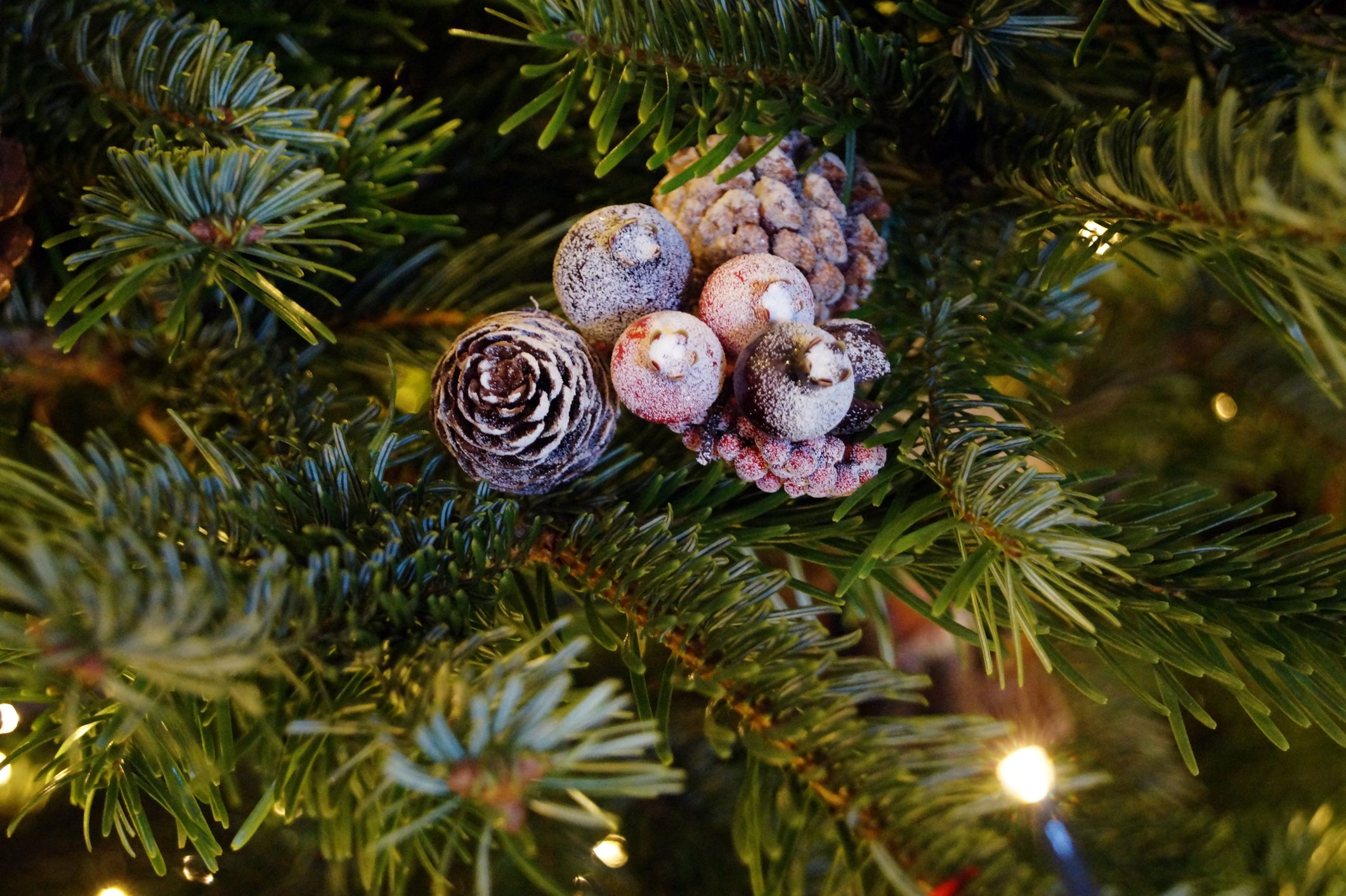
Dear Eartha, holiday cards from friends and family are already lining my shelves. Can I recycle cards? What about wrapping paper?
When it’s time to dispose of our worn-out holiday decorations, it can be difficult to know whether they go in recycling or trash. But don’t get discouraged. With a few simple steps you can make sure all that holiday cheer ends up in the right bin.
Cards and wrapping paper
 To answer your question, paper cards – even the thickest ones – can be recycled in your single-stream bin at home or in the mixed paper bin at the Recycling Centers. But we all know that holiday waste goes well beyond cards.
Consider wrapping paper, which is a little more complicated. To tell if your wrapping paper can be recycled, run it through a few tests. First, scrunch it into a ball. If that ball holds its shape, your wrapping paper has passed the first test. Second, tear your wrapping paper. If you can clearly see the paper fibers, recycle it with mixed paper. If, on the other hand, you tear it and uncover a layer of plastic or foil, toss it in the trash. Recyclable wrapping paper can be placed in your single-stream bin at home or in the mixed paper bin at the Recycling Centers. Tissue paper belongs in the trash.
Some of my crafty friends use plain brown paper (I reuse brown paper shopping bags), which can be recycled in your single-stream bin at home, or in the cardboard/paperboard bin at the Recycling Centers. Be sure to remove bows, tags, and strings before recycling.
Christmas trees: real or fake?
Despite the joy they bring, Christmas trees have sparked heated environmental debates. Manufactured out of PVC (polyvinyl chloride), artificial trees are not recyclable and will last forever in a landfill. Through the manufacturing process, PVC emits carcinogenic compounds into our atmosphere and can continue to pollute our indoor air quality after we bring a tree home.
On the other side of the spectrum, if a real tree is properly disposed of, several studies have found an environmental advantage for supporting the real tree industry. Christmas trees are a commercially farmed agricultural commodity with roughly 350 million trees currently growing on farms across the US. Every year, nearly 30 million trees are harvested from this supply and replanted on an annual cycle.
Here in Summit County, you can purchase a permit to cut down your own lodgepole pine tree. You’ll receive a map of cutting locations and instructions on which trees are ok to cut. Responsibly thinning certain trees like lodgepole pines can benefit forest health. And, our community supports the proper disposal of real Christmas trees – purchased or harvested – every year. The High County Conservation Center annually published a list drop-off locations and more holiday recycling tips.
If you’re ready to get rid of an artificial tree, consider reselling yours online if it’s in good condition. You can also donate artificial trees to a local non-profit, church, or charity, or give it away to a friend. Alternatively, re-purpose your artificial tree to make wreaths or garland.
Holiday lights that use less energy
To answer your question, paper cards – even the thickest ones – can be recycled in your single-stream bin at home or in the mixed paper bin at the Recycling Centers. But we all know that holiday waste goes well beyond cards.
Consider wrapping paper, which is a little more complicated. To tell if your wrapping paper can be recycled, run it through a few tests. First, scrunch it into a ball. If that ball holds its shape, your wrapping paper has passed the first test. Second, tear your wrapping paper. If you can clearly see the paper fibers, recycle it with mixed paper. If, on the other hand, you tear it and uncover a layer of plastic or foil, toss it in the trash. Recyclable wrapping paper can be placed in your single-stream bin at home or in the mixed paper bin at the Recycling Centers. Tissue paper belongs in the trash.
Some of my crafty friends use plain brown paper (I reuse brown paper shopping bags), which can be recycled in your single-stream bin at home, or in the cardboard/paperboard bin at the Recycling Centers. Be sure to remove bows, tags, and strings before recycling.
Christmas trees: real or fake?
Despite the joy they bring, Christmas trees have sparked heated environmental debates. Manufactured out of PVC (polyvinyl chloride), artificial trees are not recyclable and will last forever in a landfill. Through the manufacturing process, PVC emits carcinogenic compounds into our atmosphere and can continue to pollute our indoor air quality after we bring a tree home.
On the other side of the spectrum, if a real tree is properly disposed of, several studies have found an environmental advantage for supporting the real tree industry. Christmas trees are a commercially farmed agricultural commodity with roughly 350 million trees currently growing on farms across the US. Every year, nearly 30 million trees are harvested from this supply and replanted on an annual cycle.
Here in Summit County, you can purchase a permit to cut down your own lodgepole pine tree. You’ll receive a map of cutting locations and instructions on which trees are ok to cut. Responsibly thinning certain trees like lodgepole pines can benefit forest health. And, our community supports the proper disposal of real Christmas trees – purchased or harvested – every year. The High County Conservation Center annually published a list drop-off locations and more holiday recycling tips.
If you’re ready to get rid of an artificial tree, consider reselling yours online if it’s in good condition. You can also donate artificial trees to a local non-profit, church, or charity, or give it away to a friend. Alternatively, re-purpose your artificial tree to make wreaths or garland.
Holiday lights that use less energy
 Observable from space, our festive holiday lights make the average American suburb 50 percent brighter between Thanksgiving and New Years Day. The Department of Energy estimates that Americans burn 6.6 billion kilowatt-hours annually using holiday lights. That’s enough electricity to power more than 800,000 homes for a year. Equally astounding, we stand to save a tremendous portion of this energy use.
Start with LEDs. Not only do they last far longer, LEDs use 80 to 90 percent less energy than standard incandescent bulbs. Newer models come in a wide variety of shapes and colors and even produce that classic warm glow we’ve grown to love. The marginal price increase for LEDs is oftentimes earned back in the form of energy savings within one to two years of use during the holiday seasons. If you have a bad string of lights that can’t be repaired, recycle them free as electronic waste at the Summit County Resource Allocation Park.
Remember, you can keep the holidays festive – we probably all need it right now – while doing right by our planet.
Observable from space, our festive holiday lights make the average American suburb 50 percent brighter between Thanksgiving and New Years Day. The Department of Energy estimates that Americans burn 6.6 billion kilowatt-hours annually using holiday lights. That’s enough electricity to power more than 800,000 homes for a year. Equally astounding, we stand to save a tremendous portion of this energy use.
Start with LEDs. Not only do they last far longer, LEDs use 80 to 90 percent less energy than standard incandescent bulbs. Newer models come in a wide variety of shapes and colors and even produce that classic warm glow we’ve grown to love. The marginal price increase for LEDs is oftentimes earned back in the form of energy savings within one to two years of use during the holiday seasons. If you have a bad string of lights that can’t be repaired, recycle them free as electronic waste at the Summit County Resource Allocation Park.
Remember, you can keep the holidays festive – we probably all need it right now – while doing right by our planet.
 To answer your question, paper cards – even the thickest ones – can be recycled in your single-stream bin at home or in the mixed paper bin at the Recycling Centers. But we all know that holiday waste goes well beyond cards.
Consider wrapping paper, which is a little more complicated. To tell if your wrapping paper can be recycled, run it through a few tests. First, scrunch it into a ball. If that ball holds its shape, your wrapping paper has passed the first test. Second, tear your wrapping paper. If you can clearly see the paper fibers, recycle it with mixed paper. If, on the other hand, you tear it and uncover a layer of plastic or foil, toss it in the trash. Recyclable wrapping paper can be placed in your single-stream bin at home or in the mixed paper bin at the Recycling Centers. Tissue paper belongs in the trash.
Some of my crafty friends use plain brown paper (I reuse brown paper shopping bags), which can be recycled in your single-stream bin at home, or in the cardboard/paperboard bin at the Recycling Centers. Be sure to remove bows, tags, and strings before recycling.
Christmas trees: real or fake?
Despite the joy they bring, Christmas trees have sparked heated environmental debates. Manufactured out of PVC (polyvinyl chloride), artificial trees are not recyclable and will last forever in a landfill. Through the manufacturing process, PVC emits carcinogenic compounds into our atmosphere and can continue to pollute our indoor air quality after we bring a tree home.
On the other side of the spectrum, if a real tree is properly disposed of, several studies have found an environmental advantage for supporting the real tree industry. Christmas trees are a commercially farmed agricultural commodity with roughly 350 million trees currently growing on farms across the US. Every year, nearly 30 million trees are harvested from this supply and replanted on an annual cycle.
Here in Summit County, you can purchase a permit to cut down your own lodgepole pine tree. You’ll receive a map of cutting locations and instructions on which trees are ok to cut. Responsibly thinning certain trees like lodgepole pines can benefit forest health. And, our community supports the proper disposal of real Christmas trees – purchased or harvested – every year. The High County Conservation Center annually published a list drop-off locations and more holiday recycling tips.
If you’re ready to get rid of an artificial tree, consider reselling yours online if it’s in good condition. You can also donate artificial trees to a local non-profit, church, or charity, or give it away to a friend. Alternatively, re-purpose your artificial tree to make wreaths or garland.
Holiday lights that use less energy
To answer your question, paper cards – even the thickest ones – can be recycled in your single-stream bin at home or in the mixed paper bin at the Recycling Centers. But we all know that holiday waste goes well beyond cards.
Consider wrapping paper, which is a little more complicated. To tell if your wrapping paper can be recycled, run it through a few tests. First, scrunch it into a ball. If that ball holds its shape, your wrapping paper has passed the first test. Second, tear your wrapping paper. If you can clearly see the paper fibers, recycle it with mixed paper. If, on the other hand, you tear it and uncover a layer of plastic or foil, toss it in the trash. Recyclable wrapping paper can be placed in your single-stream bin at home or in the mixed paper bin at the Recycling Centers. Tissue paper belongs in the trash.
Some of my crafty friends use plain brown paper (I reuse brown paper shopping bags), which can be recycled in your single-stream bin at home, or in the cardboard/paperboard bin at the Recycling Centers. Be sure to remove bows, tags, and strings before recycling.
Christmas trees: real or fake?
Despite the joy they bring, Christmas trees have sparked heated environmental debates. Manufactured out of PVC (polyvinyl chloride), artificial trees are not recyclable and will last forever in a landfill. Through the manufacturing process, PVC emits carcinogenic compounds into our atmosphere and can continue to pollute our indoor air quality after we bring a tree home.
On the other side of the spectrum, if a real tree is properly disposed of, several studies have found an environmental advantage for supporting the real tree industry. Christmas trees are a commercially farmed agricultural commodity with roughly 350 million trees currently growing on farms across the US. Every year, nearly 30 million trees are harvested from this supply and replanted on an annual cycle.
Here in Summit County, you can purchase a permit to cut down your own lodgepole pine tree. You’ll receive a map of cutting locations and instructions on which trees are ok to cut. Responsibly thinning certain trees like lodgepole pines can benefit forest health. And, our community supports the proper disposal of real Christmas trees – purchased or harvested – every year. The High County Conservation Center annually published a list drop-off locations and more holiday recycling tips.
If you’re ready to get rid of an artificial tree, consider reselling yours online if it’s in good condition. You can also donate artificial trees to a local non-profit, church, or charity, or give it away to a friend. Alternatively, re-purpose your artificial tree to make wreaths or garland.
Holiday lights that use less energy
 Observable from space, our festive holiday lights make the average American suburb 50 percent brighter between Thanksgiving and New Years Day. The Department of Energy estimates that Americans burn 6.6 billion kilowatt-hours annually using holiday lights. That’s enough electricity to power more than 800,000 homes for a year. Equally astounding, we stand to save a tremendous portion of this energy use.
Start with LEDs. Not only do they last far longer, LEDs use 80 to 90 percent less energy than standard incandescent bulbs. Newer models come in a wide variety of shapes and colors and even produce that classic warm glow we’ve grown to love. The marginal price increase for LEDs is oftentimes earned back in the form of energy savings within one to two years of use during the holiday seasons. If you have a bad string of lights that can’t be repaired, recycle them free as electronic waste at the Summit County Resource Allocation Park.
Remember, you can keep the holidays festive – we probably all need it right now – while doing right by our planet.
Observable from space, our festive holiday lights make the average American suburb 50 percent brighter between Thanksgiving and New Years Day. The Department of Energy estimates that Americans burn 6.6 billion kilowatt-hours annually using holiday lights. That’s enough electricity to power more than 800,000 homes for a year. Equally astounding, we stand to save a tremendous portion of this energy use.
Start with LEDs. Not only do they last far longer, LEDs use 80 to 90 percent less energy than standard incandescent bulbs. Newer models come in a wide variety of shapes and colors and even produce that classic warm glow we’ve grown to love. The marginal price increase for LEDs is oftentimes earned back in the form of energy savings within one to two years of use during the holiday seasons. If you have a bad string of lights that can’t be repaired, recycle them free as electronic waste at the Summit County Resource Allocation Park.
Remember, you can keep the holidays festive – we probably all need it right now – while doing right by our planet.
